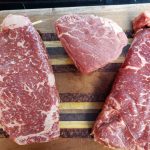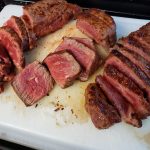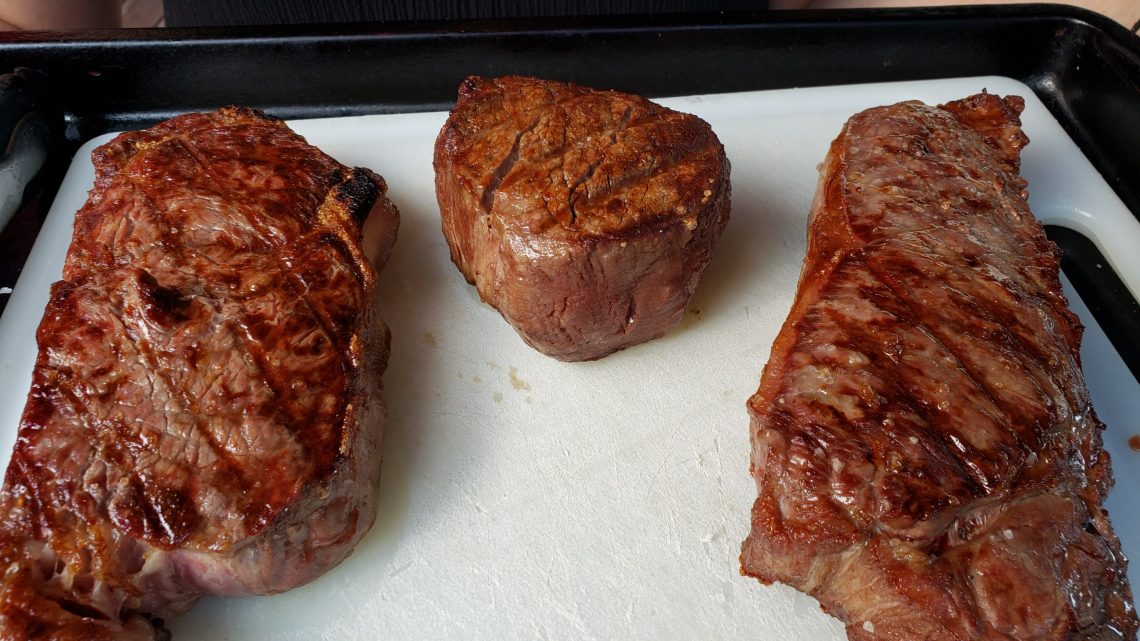
Restaurant quality prime steaks.
Right off the bat, the steaks looked different. Streaks and flecks of fat were evenly and lavishly visible throughout the meat — a look vastly different from supermarket steaks. This was a dry-aged, prime, steakhouse steak.
Restaurants, particularly steakhouses, have access to the best meat — beef that is seldom seen at retail and never in supermarkets. Meat graded USDA prime is only 2 to 3 percent of all the beef in America, and only about half of that is worthy of the best restaurants.
It doesn’t come cheap. These are the steaks that can cost as much as dinner for two on a lesser establishment menu. But for beef lovers, it’s a worthwhile splurge. A top-notch, dry-aged, prime steak is a luxury to be savored once in a while or once in a lifetime.
In a pantry box from The Tavern at Gray Barns in Norwalk, I got my first taste of a restaurant quality steak at home. Offered as a take-out alternative in the early days of the pandemic, the boxes offered enough food for a couple meals along with recipes and cooking instructions from the chef.
Back in April our box included two heavily-marbled boneless strip steaks. From the information on the label, I was able to research the source — Master Purveyors in New York. It was quickly apparent that the dry-aged steaks would be an exceptional eating experience. Pan-seared and finished in the oven to medium rare, they lived up to their promise.
Master Purveyors is a second generation family business founded in 1957. It’s been supplying the best New York restaurants, including The 21 Club and the legendary Peter Luger steakhouse, since the beginning.
Like so many in the wholesale food chain, the pandemic has forced MP to reach out directly to consumers. At their website, masterpurveyors.com, restaurant-quality meat can be ordered for home delivery.
For the very best flavor and texture, a steak, even the best prime steak, must be carefully chosen and then aged. Mark Solasz, VP and sales director, explained how they do it:
At Master Purveyors they only buy from preferred packers across the country where they know the growing conditions and feed. Only the best breeds of cattle, mostly Angus, are acceptable. Animals raised north of the 42nd parallel make the cut — the best beef cattle don’t thrive in hot weather.

Dry aged on the left, wet aged on the right.
He went on to explain the two methods of aging. Wet-aged beef is sealed in a vacuum bag for 14 to 21 days. During that time naturally occurring lactic acid tenderizes the meat but does not enhance flavor.
With dry aging, the meat rests in temperature and humidity-controlled open air for 21 to 28 days while an enzyme in the meat both tenderizes and enhances flavor. The meat loses 15 to 20% of its water weight. It “cuts dry” when portioned into steaks but is “still juicy when cooked” from the fat marbled evenly throughout the muscle. Dry-aged meat will be labeled as such and cost more.
According to Mark, “A beautiful, fully-marbled, Angus, dry-aged steak eats best.” I have to agree.
We ordered three steaks from MP for a family occasion: boneless strip steaks both dry aged ($38) and wet aged ($31) along with a filet mignon ($37). The 14 oz strip steaks easily serve two. At 8 oz, the filet is a generous portion for one.
 Grilled over hardwood charcoal, the steaks were all tender and flavorful, but everyone wanted seconds on the dry aged. It had more flavor, a buttery texture, and plenty of juice. Though all were good, it was best.
Grilled over hardwood charcoal, the steaks were all tender and flavorful, but everyone wanted seconds on the dry aged. It had more flavor, a buttery texture, and plenty of juice. Though all were good, it was best.
For a real steakhouse eating experience, you need a blazing hot fire. A high-heat sear quickly creates a flavorful crust while keeping the meat pink and juicy inside — the holy grail of perfect medium rare.
At home this can be done outside over a hot fire or inside by searing in a heavy pan and finishing with a few minutes in the oven. It takes a little practice. Mark emphasized that the meat needs to rest a few minutes when it comes off the heat for the juices to reabsorb.
 Don’t want to go through all that? Excellent steaks are to be had in some local restaurants. We enjoyed a perfectly cooked strip steak at Blackstone’s in Norwalk with the classic steakhouse sides — creamed spinach and sautéed mushrooms. They offer a notable tomato and bacon salad to start.
Don’t want to go through all that? Excellent steaks are to be had in some local restaurants. We enjoyed a perfectly cooked strip steak at Blackstone’s in Norwalk with the classic steakhouse sides — creamed spinach and sautéed mushrooms. They offer a notable tomato and bacon salad to start.
Blackstone’s menus in Stamford and Greenwich include steaks from Master Purveyors. The Tavern at Gray Barns in Norwalk, The Brick Walk Tavern in Fairfield, and The J House in Greenwich also buy from MP. Washington Prime in SoNo also offers dry-aged strip steaks.
I asked Mark what cut he preferred. “Rib eye for the mix of textures or porterhouse to get both the loin and filet in one cut,” he said. “But I’m a meat guy,” he went on, “I like to eat good beef.”
“Last Sunday we had skirt steaks on the grill,” Mark shared, “marinated with soy sauce, brown sugar, lemon pepper, garlic, and olive oil. I like to brush on marinade over the fire to bring up some flame for more char.”
“Burgers, steaks, and more — some people don’t understand the attraction of beef,” Mark said. We both agreed it’s probably because they haven’t had the best.
If you know anyone who would enjoy a peek behind the restaurant kitchen door like this, please pass this along and encourage them to join us. Thanks, Frank
Frank Whitman can be reached at NotBreadAloneFW@gmail.com.












No Comment